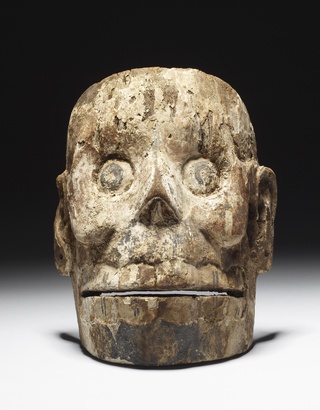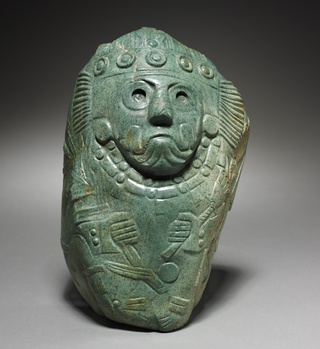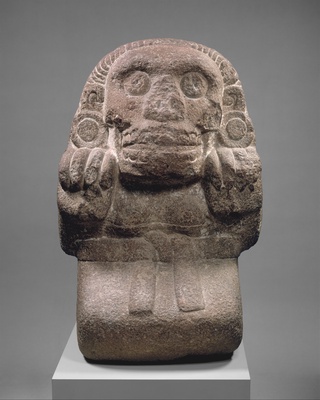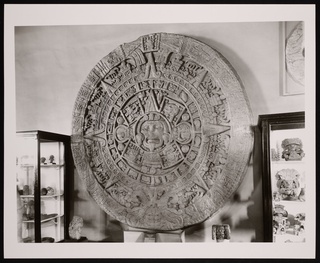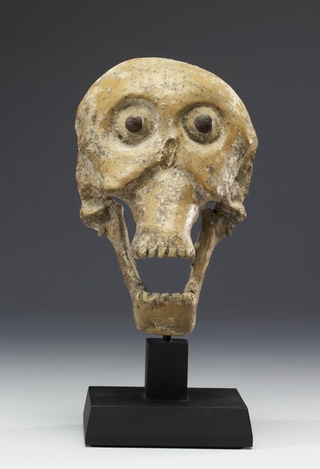Aztec Death Practices
By Magali Delgado•February 2023•12 Minute Read
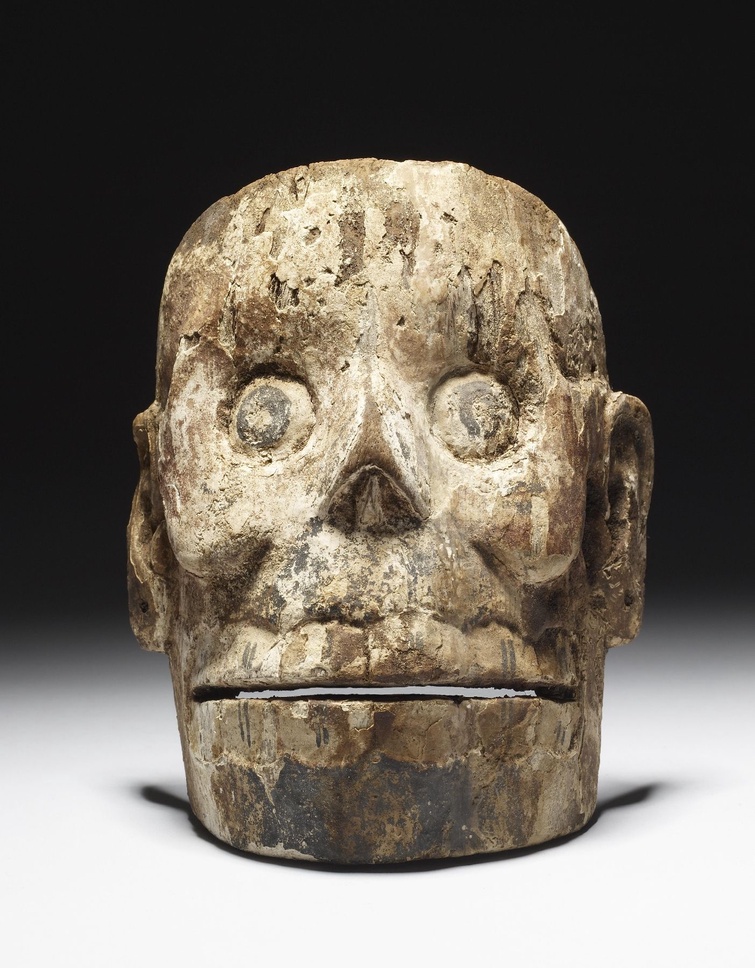
Aztec (Mexica), Mask of Mictlantecuhtli, Lord of the Underworld, 1450-1521. A wood mask representing Mictlantecuhtli, the Mexica god of the underworld.
Aztec people developed elaborate death rituals in order to thank the gods and help loved ones to the afterlife. Their beliefs and practices around death persist among Indigenous Mexican people to this day, as well as in the Día de los Muertos celebration.
In today’s Mexico, there are numerous popular practices that celebrate and honor the dead. Most of these practices have their roots in pre-Hispanic rituals centered around a belief in the afterlife. These celebrations are fundamental to the cultural identity of Mexicans.
The Aztec Afterlife
Many traditional belief systems contend that one’s destiny after death depends on ethical behavior during life. In contrast, the Aztecs believed that a person’s eternal destination depended on the circumstances of their death. Modern scholars have gathered information about Aztec beliefs concerning the afterlife through art and codices.
A consistent characteristic across Mesoamerican religions was the belief that each individual had at least two souls, and that each of them faced different destinies after death. One of the souls stayed with the corpse. This is why Mesoamerican people buried their dead in the family grounds. The other one went to the afterworld.1
For the Mexica, the souls that went to the afterworld had three different potential destinations depending on the mode of death. People who drowned, were struck by lightning, or died from water-related illnesses like leprosy, mange, and hydropsy were buried, not cremated, and went to Tlālōcān. There, they would spend glorious eternity next to the god of rain, Tlāloc.2
Those who died of natural causes or of general illnesses were cremated. They would go to Mictlān with the god of death, Mictlāntēcuhtli. Those who were condemned to death for social transgressions would also go to the Mictlān. The god would submit all souls bound for Mictlān to four years of challenges and punishments. At the end of the four years, they would find total darkness and would vanish from existence.
Those who were killed in combat or sacrificed as war prisoners, or mothers who died during childbirth, would go to Ōmeyōcān. There, Ōmeteōtl, the god of life and duality, would allow the warriors to escort the sun during sunrise. The women would accompany it during sunset. This reflected a celebration of the achievements of warriors and the sacrifice of birthing mothers.3
The Journey to Mictlān
The dead who went to Mictlān endured four years of punishments through eight trials, before reaching the ninth and final destination. Those trials included:
1) Apanoayan: A river where a Xoloitzcuintli, a hairless dog, would help the deceased swim across.
2) Tepeme Monamictia: The place where two mountains constantly crash into each other.
3) Iztepetl: A hill made of sharp obsidian knives.
4) Cehuecáyan: A frozen place.
5) Itzehecáyan: A site where an obsidian wind blows, cutting like stone knives.
6) Teocoylehualoyan: The space where a jaguar appears and devours the heart of the dead.
7) Apanhuiayo: A lake of black water where a giant iguana tries to stop the journey of the souls.
8) Chiconauapan: This is the last site before arriving at Mictlán. The souls get to the shore of this nine-fold river with the help of the Xoloitzcuintli.
9) Mictlān: The final destination, the place of complete darkness where souls would vanish for eternity.4
Community Grieving and Death Rituals
Loved ones incinerated the bodies of those who died of natural causes to help their souls on their journey to Mictlān. Before enshrouding the body, a midwife cut a lock of hair from the top of the head of the deceased. This lock, plus another taken on the day of birth, were put together inside the urn with the ashes. The Aztecs believed that part of the soul resided in the person’s hair and that, by putting together hair and ashes, they reunited the body and the spirit.5
Community members also incinerated food, tools, and pets to support the deceased on their journey. The journey to Mictlān was easier for the rich than for the poor, since they were incinerated with more resources. During the four years it took for a soul to reach Mictlān, the families carried out celebrations to accompany their dead. They offered incense, blankets, dresses, corn, fruits, flowers, paper, and statuettes that resembled the deceased.6
The idea of eternal disappearance after four years of suffering, and the discriminatory system in which just a minority of people could, voluntarily or accidentally, achieve eternal life, created feelings of bewilderment, anguish, and despair. These feelings are reflected in many Aztec poems where writers expressed their pain about the definitive nature of their destinies.7
Sacrifice
Spanish colonizers and colonial historians often sensationalized Aztec rituals involving human sacrifice, using them as justification for colonization. Of course, this neglects that European colonization in the Americas involved a scale of violence nearly unmatched in human history.8 Some modern-day scholars caution that accounts of Aztec human sacrifice continue to carry this colonial bias.9 Here, we draw on the interpretations of scholars like David Carrasco, who use archaeological evidence and Spanish and Aztec sources from shortly after colonization to argue that sacrificial practices reveal core parts of Mexica cosmovision. Namely, the Mexica believed they needed to aid the gods in their cycle of regeneration and thus ensure the continuity of creation.
Sacrifice and Mexica Cosmovision
The Mexica believed that all life started with the self-sacrifice of a group of gods. They abandoned their cosmic region and sent themselves to the underworld. After a period of incubation in the underworld, they came to the Earth’s surface and covered their essence with the matter of life. Then, the first solar cycle started and, with it, a cyclical system of creation, destruction, and rebirth of life. These cycles perpetuate the relationship between the world of the gods and the world of creatures, who are divine beings with material, mortal living bodies.10
Within Mexica cosmovision, human sacrifice was necessary to pay back the gods for this primordial sacrifice. Payment would ensure continuity of the cycle of life and death. Self-sacrifice, primarily in the form of bloodletting, was a common practice across all strata of Mexica society. Devotees would non-fatally pierce or cut themselves with obsidian blades, sharp bones, or maguey spines and bleed onto leaves, feathers, or the earth. In doing so, the devotee gave the gods some of their sacred life-force, and thus helped sustain the world.11 12
On ceremonial occasions, Mexica priests practiced the ritual killing of human beings as a form of debt-repayment to the gods. The sacrificed individuals, or nextlahualtin, were seen as more than offerings. During the sacrificial ritual, they became receptacles of their very own divine spirits, thus reenacting the divine sacrifice that created the earth.13
Sacrificed individuals were commonly male prisoners of war. But women and children were also sacrificed during specific festivals as part of the Mexica religious calendar. These rituals often related to the powerful, regenerative fertility of both women and corn.14
Sacrifice and the Aztec State
The sacrifice of prisoners of war illustrated the ritual and political importance of battle for the Mexica people. The Codex Mendoza, an illustrated manuscript created by Aztec scribes shortly after Spanish colonization, details the honors bestowed upon warriors who captured enemies in battle.15 These sacrificed warriors could expect glory in Ōmeyōcān. These sacrifices likely also functioned as displays of Aztec might to political rivals—a purpose researchers have observed in practices of human sacrifice in different eras across the world.16 17
Some of the most valuable known artifacts related to Aztec ritual life, including sacrifice, were found during the excavations of the Templo Mayor in Mexico City. One example is the monumental Aztec Sun Stone. Scholars think that in some ceremonies, a priest would kill a captured warrior—in that moment, a divine being—on top of the sun stone. The priest would symbolically feed the person’s blood to the gods.18 The inscriptions of the stone represented, among other things, the current cycle of creation, which is known as the fifth sun.
Celebrations of Death
In addition to family rituals marking individual deaths, Aztec people observed collective celebrations of death. The most important one took place in the time of the year known in the Aztec calendar as Quecholli.19 This occurs in autumn, coinciding with the Spanish Catholic observation of All Saints and Faithful Departed. This parallel timing probably helped the colonial Spanish goal of the evangelization of Indigenous people.20
Mexican Indigenous people adopted the Catholic festivity and carried it into the present. Most elements of the original Aztec offerings are still present in the altars assembled to commemorate the Day of the Dead, or Día de Muertos. Nowadays, the celebrations of Día de Muertos are full of color, light, food, music, catrinas, calaveras, literary calaveras, and a respectful irreverence towards the idea of death. This tradition has grown stronger over time. It is a symbol of national identity and has helped Mexican society embrace its mixed origins.21
Today, Indigenous communities continue key rituals and beliefs around death. The Nahuas of the Zongolica mountains were influenced directly by Aztec culture. They have preserved some pre-Hispanic rituals interfused with Catholic doctrine.
The contemporary Nahua people honor their own unique cultural traditions, too. Like the Aztecs, who also spoke Nahuatl, they believe in the afterlife. However, perhaps due to Catholic influences, they believe that the destination of the soul depends on the actions of the person in life. They believe in a good place for the afterlife called the Ilwikatl, and a place of eternal suffering called the Mictlān. They pray, sing, and offer holy water, food, cacao beans, and other elements to their deceased to accompany their journey to Ilwikatl.
The Nahuas continue their funerary rituals every year for four years after the day of death. The Nahua people also believe that the souls are accompanied by a dog in their journey and, because of that, it is very important to take care of their pet dogs in life.22
Death inspires a variety of feelings and practices among different world cultures. By examining Aztec practices related to death, as we have briefly done, we can understand how pre-Hispanic influences affect diverse Mexican beliefs and rituals around death to this day. And we can see a through-line in attitudes toward death as a time of celebration and respect for the divine and human from before the colonial period to the practices of many contemporary Latin Americans.
Citations
Austin, Alfredo López. Breve historia de la tradición religiosa mesoamericana. Universidad Nacional Autónoma de México, 2002, p. 34, http://ru.iia.unam.mx:8080/bitstream/10684/54/1/205.pdf. Accessed 2 October 2022
Ruz, Alberto. “El Pensamiento Náhuatl Acerca de La Muerte.” Estudios de Cultura Náhuatl, vol. 04, no. 52, 1963, pp. 251–61, https://nahuatl.historicas.unam.mx/index.php/ecn/article/view/78611. Accessed 30 June 2022.
“El Pensamiento Náhuatl Acerca de La Muerte.”
Lacunza, Michel Olguín. “Mictlantecuhtli, El Dios Mexica de La Muerte.” Gaceta UNAM, 31 October 2020, https://www.gaceta.unam.mx/mictlantecuhtli-el-dios-mexica-de-la-muerte/. Accessed 23 August 2022.
Keraudren, Patrick Johansson. “Días de Muertos En El Mundo Náhuatl Prehispánico.” Estudios de Cultura Náhuatl, vol. 34, no. 678, 2003, pp. 168–203, https://www.historicas.unam.mx/publicaciones/revistas/nahuatl/pdf/ecn34/678.pdf. Accessed 23 August 2022.
Berrueco, Adriana. “Raíces Indígenas de Las Ofrendas a Los Difuntos.” Hechos y Derechos, 1 November 2012, https://revistas.juridicas.unam.mx/index.php/hechos-y-derechos/article/view/6739/8675. Accessed 23 August 2022.
“El Pensamiento Náhuatl Acerca de La Muerte.”
Carrasco, David. “Sacrifice/Human Sacrifice in Religious Traditions.” In Religion and Violence, edited by Mark Juergensmeyer, Margo Kitts, and Michael Jerryson. Oxford University Press, 2013, pp. 209–235, https://dash.harvard.edu/bitstream/handle/1/34814073/Carrasco_Sacrifice1%20%282%29.pdf. Accessed 28 November 2022.
Jaansen, Maarten E.R.G.N and Aurora Pérez Jiménez. “Sacrifice in Ancient Mexico.” In Aztecs, edited by Martin Berger, Inés de Castro, and Doris Kurella. Hirmer Press, 2019, pp. 254–265. For more on colonial distortions of Aztec belief, see: Townsend, Camilla. “We Learned About the Aztecs from their Conquerors — But New Research is Letting Them Speak for Themselves.” Time, 1 November 2019, https://time.com/5715476/aztec-history-myths/. Accessed 28 November 2022. See also: Foster, Jackson. “A History of the Aztecs on their Terms: A Q&A with NEH Public Scholar Camilla Townsend.” National Endowment for the Humanities, 28 October 2020, https://www.neh.gov/blog/history-aztecs-their-terms-qa-neh-public-scholar-camilla-townsend. Accessed 28 November 2022.
Carrasco, David.The Aztecs: A Very Short Introduction. Oxford University Press, 2011, pp. 69, https://books.google.pt/books?redir_esc=y&id=haGSJ_XVshsC&q=nextlahualtin#v=snippet&q=nextlahualtin&f=false. Accessed 26 October 2022.
Graulich, Michel. “Autosacrifice in Ancient Mexico.” Estudios de Cultura Náhuatl, issue 26, 2015, pp. 301-329. Accessed 26 October 2022.
“Sacrifice in Ancient Mexico.”
Carrasco, The Aztecs: A Very Short Introduction.
Carrasco, “Sacrifice/Human Sacrifice in Religious Traditions.”
“Folio 64r.” Códice Mendoza, https://codicemendoza.inah.gob.mx/index.php?lang=english&folio_number=70&type=r§ion=t. Accessed 23 August 2022.
Carrasco, “Sacrifice/Human Sacrifice in Religious Traditions.”
Watts, Joseph, Oliver Sheehan, Quentin D. Atkinson, et al. “Ritual Human Sacrifice Promoted and Sustained the Evolution of Stratified Societies.” Nature, vol. 532, 4 April 2016, pp. 228–231, https://www.nature.com/articles/nature17159. Accessed 28 November 2022.
Carrasco, “Sacrifice/Human Sacrifice in Religious Traditions.”
“Raíces Indígenas de Las Ofrendas a Los Difuntos.”
Guzmán, Fernando. “Día de Muertos, Una Fiesta Para Evangelizar.” Gaceta UNAM, 31 October 2020, https://www.gaceta.unam.mx/dia-de-muertos-una-fiesta-para-evangelizar/. Accessed 23 August 2022.
Smith, Anthony D. “Nacionalismo e Indigenismo: La Búsqueda de Un Pasado Auténtico.” Estudios Interdisciplinarios de América Latina y El Caribe, vol. 1, no. 2, 2007, pp. 1–17.
Rodríguez, María Teresa. “Rituales De Muerte Y Parentesco En La Tradición Nahua De La Sierra De Zongolica.” Diálogo Andino - Revista de Historia, Geografía y Cultura Andina, no. 40, 2012, pp. 97–110.
